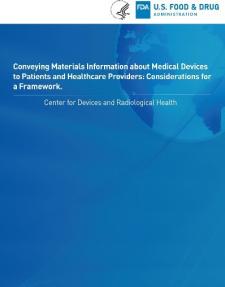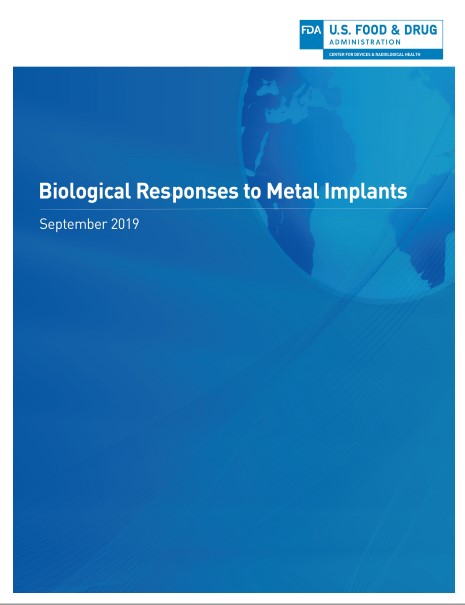Safety of Metals and Other Materials Used in Medical Devices
On May 20, 2021, the FDA published a discussion paper, Conveying Materials Information about Medical Devices to Patients and Healthcare Providers: Considerations for a Framework, intended to stimulate discussion and to solicit feedback from a variety of stakeholders on how materials information could be communicated. The discussion paper highlights considerations for labeling of medical devices as it relates to material composition of the device.
The FDA accepted feedback through August 18, 2021 in a public docket FDA-2021-N-0334.
Numerous types of materials, including metals, polymers and ceramics, are commonly used in medical devices, and these materials can be in contact with parts of the body for extended periods of time. Part of the FDA's evaluation to determine whether a medical device is safe and effective involves reviewing information about the materials used in the device.
On This Page:
- How the FDA Considers the Safety of Materials in Medical Devices
- Conveying Materials Information about Medical Devices
- FDA Statements on Materials in Medical Devices
Related Pages:
- Dental Amalgam
- Metal-on-Metal Hip Implants
- CDRH’s Research on Biological Responses to Metal-Containing Devices
- Medical Device Material Safety Summaries: ECRI Reports
How the FDA Considers the Safety of Materials in Medical Devices
Part of the FDA's evaluation of the safety and effectiveness of a device involves the premarket review of information about the materials used in the device. The FDA considers the specific properties of the material, the intended use of the device, and the function of the device when evaluating the safety of the device materials.
As part of premarket submissions, medical device manufacturers submit information such as an evaluation of biocompatibility, to the FDA to demonstrate that the materials they plan to use in their device can be safely used in or on the human body. The FDA has published guidance, which describes how a risk-based approach is utilized to determine what types of biocompatibility information are typically needed to support device material safety.
Review of Biocompatibility Data
Medical device manufacturers typically assess the biocompatibility of a material by determining how the human body may respond to the material they plan to use in their device. Manufacturers perform an evaluation of their device to determine if there is a potential adverse biological response resulting from contact of the device's materials with the body and whether the associated risks are acceptable. This risk-based approach typically includes an assessment of the device, including the material components, the manufacturing processes, the clinical use of the device including the intended anatomical location, and the frequency and duration of exposure. Information to support the biocompatibility of the device is then provided to the FDA based upon such evaluation. The FDA’s biocompatibility guidance provides recommendations on the information that should be provided.
In certain situations, medical device manufacturers may conduct other testing to model how materials in a device may behave in the body. One example is engineering testing to evaluate the potential for wear and corrosion (for metals) of a specific device through different possible mechanisms, depending on the environment in which the device is intended to be used in (for example, joint, vasculature, and so forth).
Reviews of the Latest Scientific Information
In the past several years, the FDA has undertaken extensive postmarket reviews of data associated with specific metal-containing implants after safety concerns were raised including for metal-on-metal (MoM) total hip arthroplasty (THA) systems and the Essure System for Permanent Birth Control. In those cases, the potential role of metal components raised questions about the potential for unexpected or heightened biological responses.
Building on prior work and steps outlined in the Medical Device Safety Action Plan announced in 2018, the FDA conducted a comprehensive review of metals used in implanted medical devices, due to concerns raised by patients and reported adverse events potentially related to biological responses to certain types of materials in medical devices.
In September 2019, the FDA issued a paper on biological responses to metal implants. This paper presented the FDA's review of the available scientific information related to metals and their use in medical implants. The paper focused on how metal materials are impacted by a physiological environment, expected and potential toxicologic and immune responses to the metal associated with an implant, as well as subsequent clinical manifestations. This paper also identified where gaps and opportunities for further research exist in the current scientific evidence related to immunological responses to metal-containing implants.
In November 2019, the FDA held a public advisory committee meeting (Immunology Devices Panel) to present its findings and solicit feedback from the public and experts in the field. Based upon its review and the Immunology Devices Panel feedback, several gaps were identified in the current understanding of immunological responses to metals in devices that were recommended for the FDA to consider.
Research on Immunological Responses to Products Regulated as Medical Devices
The FDA recognizes that additional work is needed to have a better understanding of the host response to an implanted metal device including the potential systemic clinical effects, the specific factors which may contribute to how an individual responds, and tests or methods to predict or identify a heightened response. Accordingly, the FDA has initiated research efforts, including working with external collaborators, to address the knowledge gaps in these areas:
- Scope and occurrence of metal implant related adverse health outcomes
- Clinically relevant in vitro tests and safety limits for corrosion/wear
- Impact of anatomical location and device characteristics on immune responses
- Clinically relevant in vivo and in vitro models for immune responses
- Standardized sampling and analysis of corrosion/wear products in biological tissue/fluids
- Optimization of existing in vitro diagnostic tests
- Biomarkers and other tools for screening and monitoring patients
For more details on these research efforts, see the FDA’s paper, Biological Responses to Metal Implants (PDF-2.9MB).
The FDA anticipates that these research efforts will form the foundation to develop the tools needed to improve premarket device evaluation of metal containing implants, the ability to screen and monitor patients, and the design of safer metal implants – all of which will help patients and physicians make sound benefit-risk decisions regarding their use.
Conveying Materials Information in Medical Device Labeling
Download new discussion paper [PDF-2.9MB]
At the November 13 and 14, 2019 meeting of the Immunology Devices Panel of the Medical Device Advisory Committee, numerous members of the public as well as the Panel expressed the need for improved product labeling for medical implants – in particular as it relates to the material composition of the devices.
Based upon these prior discussions and the Immunology Devices Panel’s recommendations on May 20, 2021 the FDA released a discussion paper to provide an initial framework to stimulate a discussion on how materials information could be communicated. The FDA believes this is an important first step to ensure patients and physicians have access to more comprehensive information on different materials (including but not limited to metal constituents) used in devices with long-term (greater than 30 day) exposure as well as repeated use so that they can make informed decisions regarding the use of medical devices.
Members of the public are encouraged to review the document and provide comments.
FDA Statements on Materials in Medical Devices
- Continued Efforts to Evaluate Materials in Medical Devices to Address Potential Safety Questions (September 2019)
- Efforts to Evaluate Materials in Medical Devices to Address Potential Safety Issues (March 2019)


